I’ve been extremely privileged to have fished many places around our great continent and by no means have I exhausted all possibilities but I have yet to encounter an estuarine system that goes close to imitating Lake Tyers.
Is it a genuine lake or just two massive rivers that start separately, conjoin along the way and then end abruptly at the mouth? Due to its size, Tyers probably lends itself more to a lake due to the sheer amount of open water available for angling, but, oh what a lake! Covering 1,600ha and surrounded mostly by bushland, you can feel that they are fishing a very isolated area indeed.
Two main arms make up most of Lake Tyers, Toorloo and the longer Nowa Nowa begin their respective estuarine journeys from the bridges that connect the Princes Highway some kilometres inland from the sea.
For those not in the know, Lake Tyers can be found just a few minutes’ drive east from Lakes Entrance along highway one in far East Gippsland.
The main species on offer to the angler are bream (mostly black with some yellowfin), luderick, tailor, Australian salmon, yellow eye and poddy mullet, garfish, estuary perch, bass and flathead (mainly duskies).
The only commercial fishing allowed in Tyers is the collection of invertebrates, such as sandworm for bait, plus some eel netting. However, the bait gathering has been put temporarily on hold due to two experimental releases of prawn larvae into the system.
Lake Tyers is one estuary that seldom opens to the sea. Unless continuous and heavy rain falls in the catchment, this system can and has been known to stay closed to the sea for some years. Prawns naturally run in this system (as they do in most other East Gippsland estuaries) but not when it has been closed for extended periods of time. So this is a little experiment carried out by Fisheries to see if adding prawn larvae to the system will benefit angling options in the warmer months by providing people with an opportunity to gather prawns on a potentially annual basis for bait or the table. Not to mention providing many fish species with a more regular food source.
Bream can be found all over the system and can be caught year round. In spring black bream will tend to move well up into the arms in search of the right salinity in which to spawn. What few yellowfin that are in the system will remain down in the lower reaches and, if and when the mouth is open, will come and go as they please.
Dusky flathead are best targeted in the warmer months and in the bottom half of the estuary. They can still be caught in the cooler months but at this time they tend to migrate right up both the arms to the extreme limit of brackish water.
Any flathead caught at this time further downstream towards the mouth will tend to be southern blue spots. As both species have different size and bag limits applied to them it would pay to be able to visually identify and separate both species (see Victorian Recreational Fishing Guide - marine and estuarine scale fish section). If in doubt, call it for a dusky.
Luderick and whiting are widespread throughout the lake but are best targeted in the lower reaches, especially when the mouth is or has been recently open to the sea.
Estuary perch are about in solid numbers but the majority of captures seem to occur in the longer Nowa Nowa arm. The reason could well be because of the greater amount of snags and fallen bank side timber available providing cover for the perch.
By far the most exciting aspect of fishing Lake Tyers is the prospect of hooking up to, playing and successfully landing a sizeable poddy mullet on bream gear. These mostly vegetarian fish can achieve weights in excess of 8kg.
My first forays on Tyers involved casting a variety of plastics and blades in the upper reaches of the Toorloo Arm in spring. Besides catching dusky flathead and bream, I would occasionally hook up to something unstoppable, which would inevitably involve a break off, no matter how careful I was. For the life of me I couldn’t work out exactly what species this was. The fish would inevitably jump but always at a distance so visual identification was left to guesswork. Were they massive tailor, or trout? I had no idea at the time. It took two trips to the upper Toorloo Arm with slightly heavier gear (3-5kg rod, 4kg braid with a 5kg fluorocarbon leader) to actually manage to land one.
The reason for the heavier gear is that the upper sections of both arms narrow off and become quite snag ridden. Poddy mullet won’t deliberately run towards a snag but it’s inevitable that one will get in the way during a prolonged fight.
Funny, that afterwards (not before) I began to notice (with the help of polarized glasses) large schools of poddy mullet slowly cruising around the upper reaches of the Toorloo Arm.
Stoney Creek is the main feeder for the Toorloo Arm and begins (or ends) at the Princes Highway Bridge. The creek is surrounded by thick bush and the only way to fish this creek is on foot, but plenty of riffles and pools can be located in the lower reaches. I mention this here because the creek is home to a population of Australian bass and is considered only lightly fished by a few local avid bass anglers. It is definitely worth the effort to walk in from the highway bridge and flick a few lures about.
The feeder creek for the Nowa Nowa arm is Boggy Creek, which is smaller and basically inaccessible on foot and not considered a viable proposition for bass if they are here at all.
Other by-catch species can come in the form of snapper (mostly juvenile) and occasionally mulloway. This occurs mainly when the mouth is open for extended periods.
There many access points available to the mobile angler without a boat. In saying that the Toorloo Arm is much more favoured for bank fishing than the Nowa Nowa Arm.
Just a few kilometres east of the Lake Tyers turnoff on highway one there is a dirt road labelled Burnt Bridge Road. I’ve found this road suitable for 2WD vehicles, except after heavy rain. From here, several sites suitable for bank fishing and picnics can be accessed. These localities are Burnt Bridge, Cherry Tree Track and Long Point.
Several kilometres further on will take the driver to Burnt Bridge Road north. From here, Crystal, Pile and Lonely Bays can be accessed. So too can Blackfellow’s Arm.
Access to areas along the Nowa Nowa Arm not only requires a much longer drive along dirt tracks but most end up at private property with no river access. In saying that, I have not explored all tracks but that’s the general gist of it.
There are five boat ramps in which to launch and explore the lake:
There are two in town but the best by far is the main one that faces Mud Island. The other is closer to the beach and is rarely used and hasn’t been. This town ramp is used mainly to access the lower reaches including the Nowa Nowa Arm.
A further two are located prior to entering the township. By turning left down Mill Point Road gives the boater more access to the Toorloo Arm. The first being Fisherman’s Landing and further along is Mill Point. This road is fully sealed.
The final ramp is accessed from the Princes Highway at the township of Nowa Nowa and is situated right at the top of the arm.
Accommodation is plentiful in both Lake Tyers as well as nearby Lakes Entrance. In fact, simply far too numerous to mention here. From camping grounds to holiday lets and right up to five star accommodations are all locally on offer. By using a computer’s search engine a myriad of options will be available to those contemplating an extended fishing trip to Lake Tyers whatever your budget may be.
Facts
Marine waters
Even though Lake Tyers spends most of its time closed off to the sea, Fisheries Victoria has designated most of the fishable water available as marine waters. The boundaries for the Toorloo arm are the downstream side of the Princes Highway Bridge. For the Nowa Nowa arm the boundary is an imaginary line running from Boggy to Ironstone Creek, which is right up near the top of the arm (see Victorian Recreational Fishing Guide).
An excellent mud map of the lake is available from the Lake Tyers Beach general store for $2 or a waterproof version (which I recommend) for $4. This map lists all ramps, roads and fishing hot spots.
Unlike the Gippsland Lakes, which are still subject to heavy estuarine commercial fishing, Lake Tyers is pristine in comparison and mostly surrounded by virgin bushland giving the impression of being a million miles from civilisation.

Scott France with an average Tyers bream taken on local prawn.
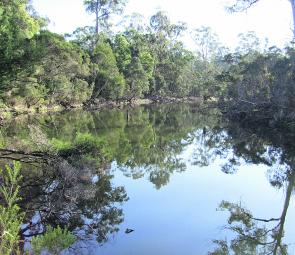
Upper reaches of the Toorloo Arm. Snag ridden and very fishy looking.

Spot the schooling bream around this snag!

Sometimes dusky flathead can be spotted cruising the shallows.
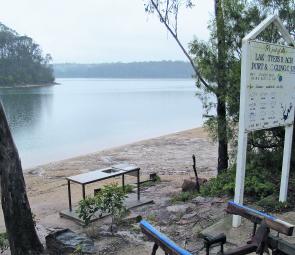
Mill Point boat ramp and bank access.
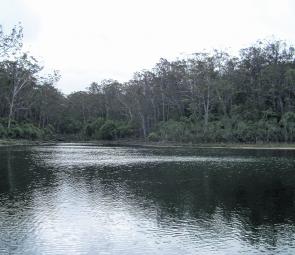
Just a few of the many smaller anabranches of the Toorloo Arm. All accessible for bank anglers.
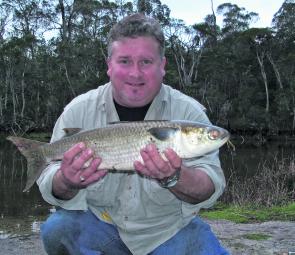
The culprit that has been breaking me off all along – a poddy mullet! And they get much bigger than this.
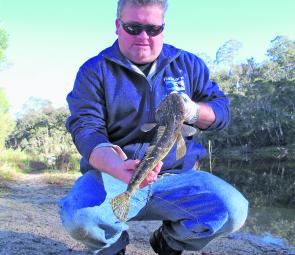
A solid Dusky tagged prior to release for FishCare Victoria.
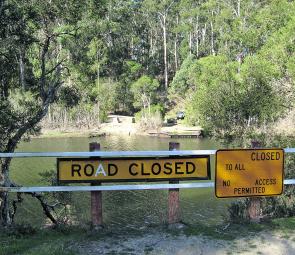
Burnt Bridge Road. Great access for the bank angler.




